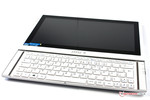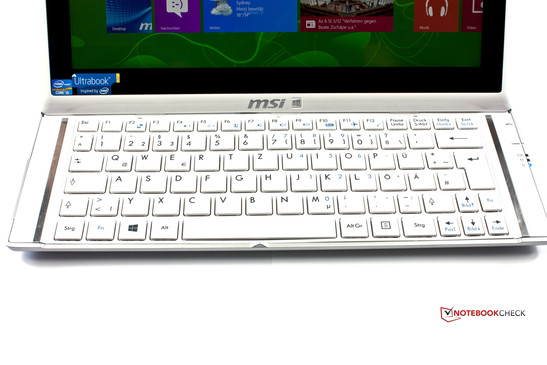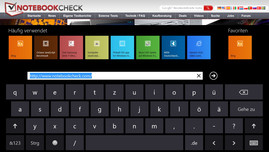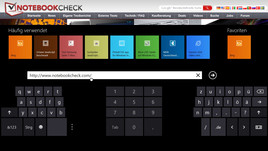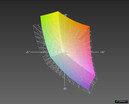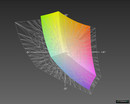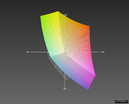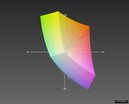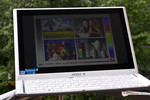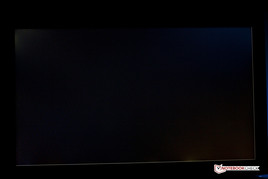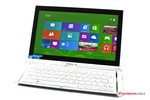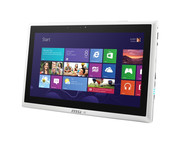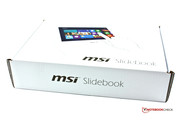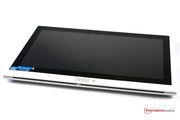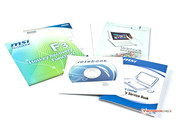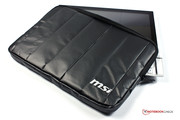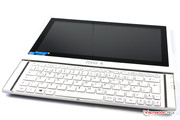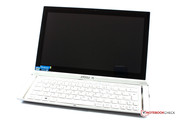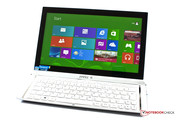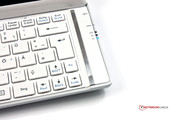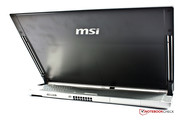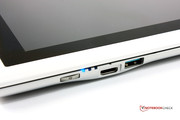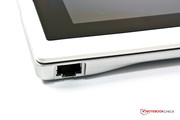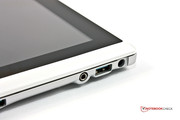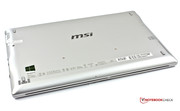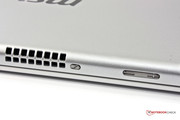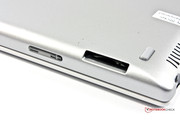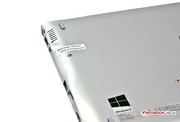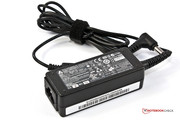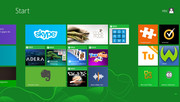Review MSI S20-i541 UltraSlider Ultrabook

For the original German review, see here.
The 11.6-inch convertible S20-i541 made by MSI has to compete against the likes of the Toshiba Satellite U920t-100 and the Sony Vaio Duo 11 SV-D1121X9EB, trying to leverage its rather low price point of less than 1000 Euros (~$1293). But next to other ultrabook-based convertibles, there is also competition from the high-powered and large-sized range of the tablet market. Plus, some of these devices such as the Acer W700-53334G12as cost around 100 Euros (~$129) less.
These competitors offer approximately the same performance as the S20-i541. All of them come equipped with a Core i5 (Ivy Bridge) and 4 GB of RAM as well as a 128 GB SSD. This review will show whether the MSI S20 manages to trump the other devices in terms of its overall impression - despite its lower price tag.
The chassis of the MSI S20-i541 UltraSlider is 302.6 millimeters wide, 196.1 millimeters long and 19.8 millimeters thick, making it somewhat smaller than the Toshiba U920t. This still feels clunky in comparison to a tablet or even the Acer W700 which measures no more than 12 millimeters in height.
The materials look more like plastic, although the base unit is supposedly made from aluminum. Unfortunately, the first impression solidifies itself once we touch the device. The white frame around the display shimmers slightly, trying to look like nacre - and failing miserably. The chassis comes with a silver finish which doesn't really fit the white display frame.
Its display is not torsion-resistant at all. Worse: Applying enough pressure from behind is actually sufficient to trigger the touchscreen. At least the sliding mechanism works well, running smoothly. Just a little push against the lower display boundary is enough to force the display back, sliding on two plastic rollers built into the base units. We are also quite impressed by the stiff display hinges which keep the screen safely in its current position. An angle of up to 90 degrees between the base unit and the display is possible.
The build quality of the base unit could be better. Some clearances are rather uneven, especially between the front of the keyboard and the rest of the case. As expected, the base unit is more torsion-resistant than the display, but it creaks noticeably.
Still, the test device rests comfortably in the hand. The rounded edges don't cut into the user's palms. It might be prudent to place the MSI S20 on the ball of the hand since 1160 grams can get unergonomically heavy when stabilized only with the wrist. The battery cannot be replaced and there is no option to connect an external battery to a battery port (such as with the Sony Vaio Duo 11).
All existing ports work reliably, but they are clustered on the right hand side of the S20. We would have liked the card reader to be positioned on the front, but it is inconveniently placed on the back. But there was also a positive surprise: Although MSI does not state this explicitly, the card reader is not only capable of reading SD and MMC cards, but also SDHC cards, allowing the internal storage to be easily expanded by up to 32 GB. Unfortunately though, the card reader is placed directly below the processor, a spot which gets quite warm when the convertible operates under full load. This may not be a problem for our fingers, but we didn't feel comfortable leaving the SD card in its reader while performing the CPU stress tests.
Both the volume rocker and the rotation lock can be found on the back. This is of some concern especially in the case of the volume rocker which may be needed more often than the rotation lock. Generally speaking, the ports could have been distributed more evenly in order to prevent a possible cable tangle on the right hand side with Line In/Out, HDMI, power adapter and two - unfortunately very stiff - USB 3.0 cables. On the left, only an Ethernet cable can be plugged in.
Communication
In contrast to its competition, the MSI S20 includes Gigabit Ethernet next to the obligatory Wi-Fi module (802.11 b/g/n). The Intel Centrino Wireless-N 2230 only works in the 2.4 GHz range, yielding average signal strength. Ten meters away from the router, two out of four bars are reached, leading to average loading times when browsing to Notebookcheck.com. The S20 utilizes Intel's Wireless Display technology, enabling the screen content to be streamed to any TV with an Intel Wireless Display receiver.
The S20 does not come equipped with a WWAN modem, having to rely on external HotSpots or tethering-enabled devices in order to access the World Wide Web on the go.
Accessories
There is not much included with the S20, just a 40 watts power adapter and a protective cover / bag (plus a warranty sheet, a service brochure, two quick start guides and a driver/utility disk). A full manual can be downloaded from the MSI website. There are no additional accessories which are associated explicitly with this device.
Maintenance
MSI's convertible has been constructed in a maintenance-friendly way. The rear panel is held by just six screws - one of which is covered by a warranty sticker. The equipped SSD is connected via mSATA making it easy to replace with a larger one should the need arise. The one RAM slot in use could be equipped with modules of up to 8 GB. Unfortunately, the manufacturer doesn't appear to be okay with the user fiddling around with the innards of the convertible: MSI mentions the possibility of such extensions, but states in the manual that only official service personnel are allowed to perform these procedures.
Warranty
MSI offers 24 months of warranty - while an additional year costs 139 Euros (~$179) more. This is quite a steep price, especially so since we are talking about a mere bring-in service.
Keyboard
The island-style keyboard is a bit cramped since the sliding mechanism requires approximately half of the space of the available space on the base unit. Thus it measures 260 x 100 millimeters, coming with 87 keys. The QWERTY keys are 14 x 14 millimeters large, offering precise strokes and a subtle clicking sound. Key travel is fine. Actually, this would be a more than decent keyboard if it didn't sag so noticeably in its center whenever pressure is applied. The keyboard isn't even plane, the keys reach different heights, something which we do not only feel but also see. Thus, we cannot recommend the S20 for prolific writers although it should suffice for infrequent smaller texts.
The S20 doesn't have a trackpoint or a touchpad.
Touchscreen
The capacitive multitouch screen is capable of handling up to ten fingers simultaneously. It has to be precise and highly reactive in order to be of any use within the touch-optimized Modern UI of Windows 8 in tablet mode - and it is. MSI's solution is fast and reliable with both gestures and simple touch. The position sensor works well too. In laptop mode, the rotation lock is activated automatically in order to prevent accidental screen rotation (although this can be deactivated with the hardware switch on the back if necessary).
The panel (N116HSE-EA1 series) is made by Chimei Innolux, which also supplies Asus and Samsung. Unfortunately, MSI seems to use older panels - both AIDA64 and the PCWizard 2012 reveal the display to have been manufactured in December 2011.
The 1920x1080 pixels of its 16:9 Full HD display offer up to 16.7 million colors (8-bit). The pixel density of 190 ppi leads to sharp images. In addition, viewing angles of this IPS display are superb. Like many other manufacturers, MSI uses a glossy display, deciding against any anti-glare coating in order to boost color vibrancy. But of course this choice requires the panel to be bright enough to overcome any reflections. On average, the S20 reaches mediocre brightness levels of 293.4 cd/m² with up to 310 cd/m² in the upper left of the screen. Acer's W700 offers a brightness of 355.2 cd/m² while the display of the Toshiba U920t only yields 262.8 cd/m². One major disadvantage of the MSI S20: Maximum brightness while running on battery drops to 233 cd/m².
| |||||||||||||||||||||||||
Brightness Distribution: 86 %
Center on Battery: 233 cd/m²
Contrast: 994:1 (Black: 0.31 cd/m²)60.8% AdobeRGB 1998 (Argyll 2.2.0 3D)
83.8% sRGB (Argyll 2.2.0 3D)
62.6% Display P3 (Argyll 2.2.0 3D)
The S20's contrast ratio of 984:1 is great, taking the top spot closely ahead of Acer's tablet (972:1) and the Satellite U920t (789:1). Black levels of 0.31 cd/m² are good as well, being on par with those of the competition. A brightness homogeneity level of 86% is also quite decent.
Color space rendition is not so great, especially with AdobeRGB, but also in the case of the sRGB color space. Thus, the panel is not suited for professionals, but neither are its competitors (which fare even worse). Luckily, graphic designers are not part of the S20's target group.
Concerning color accuracy, the panel overshoots by a long shot. While blues and yellows are fine, greens and cyans aren't. Whites could be more accurate as well: The measured color temperature of 6019 K differs considerably from our recommendation of 6500 K. Color saturation is another issue, with greens drifting into yellows, yielding a noticeable yellowish tint. This is especially annoying since green is the standard background color of the Modern UI of Windows 8. At times, this reminded us of old DOS times. At least grayscale rendition is okay. While a trained eye is able to make out some deviations, they shouldn't be of concern during actual daily usage.
Unfortunately, the brightness throttling issue of the S20 while running on battery prevents it from being truly recommendable for outdoor usage, especially in direct sunlight. But even a cloudy sky can be too bright if a wrong viewing angle on the highly reflective screen is chosen. Sitting directly in front of the laptop helps, with the S20 relying on its good contrast ratio. Still, even then a place in the shade might be preferable.
Viewing angles of the screen are great, as is often the case with IPS displays. Some slight color inversions occur beyond extreme horizontal angles of +/- 60 degrees and there is an acceptable halation effect in the upper left corner. Plus, the lower right part of the screen exhibits signs of the underlying illumination showing through in the dark.
The MSI S20-i541 UltraSlider is powered by an ULV Intel Ivy Bridge CPU manufactured using the 32 nm process. The Core i5-3337U comes with four threads and two cores, both clocked at a base speed of 1.8 GHz, clocking down to 800 MHz while idle. There is also a Turbo Boost 2.0 mode of up to 2.7 GHz (single-core mode) and 2.5 GHz (dual-core mode) respectively. With a TDP (thermal design power) of 17 watts, the CPU is one of Intel's more power-efficient models.
The processor is accompanied by 4 GB of RAM and the well-known Intel HD 4000 onboard graphics solution (without any dedicated memory) clocked at 350 to 1100 MHz which has become the de-facto standard for upper middle class ultra-mobile Windows devices.
Processor
Unfortunately, the CPU performance doesn't manage to match our expectations. While up to 2.40 points could have been reached in the Cinebench R11.5 Multi-CPU benchmark, only 1.82 was measured. This is not due to throttling issues (the Turbo Boost works perfectly with up to 2.5 GHz), but possibly due to the single channel RAM. Even the Acer W700 with its throttling issues yields 2.18 points in the same test thanks to its dual channel RAM - the base frequency which also clocks at higher speeds than that of the S20. This results in a de-facto CPU performance similar to that of an older Core i3-350M. The S20 fares better in the less RAM-demanding wPrime benchmark, yielding similar results to a nominally slightly weaker Core i5-3317U. MSI has saved on the wrong things here - the S20 should definitely have shipped with dual channel RAM.
Waste heat management works reliably, enabling the CPU to always make use of its maximum clock speed during our stress tests. Only while running on battery is the processor clocked down to 2.0 GHz - which is still well within the Turbo Boost range.
| wPrime 2.10 - 1024m (sort by value) | |
| MSI S20-i541 UltraSlider | |
| Sony Vaio Duo 11 SV-D1121X9EB | |
| Sony Vaio Tap 20 SVJ2021V1E | |
| Acer Aspire M3-481-53314G50Mass | |
| Microsoft Surface Pro | |
* ... smaller is better
System Performance
During daily usage, Windows always remained responsive, running absolutely smoothly. Still, a more detailed analysis reveals that certain components negatively affect performance, leading to the S20 staying behind our expectations within both the PCMark 7 and the PCMark Vantage benchmarks. The culprit seems to be the slow SSD, slower than any of the competition. Again, MSI should have taken more care when fine-tuning the inner components of the S20.
| PCMark Vantage | |
| 1024x768 Result (sort by value) | |
| MSI S20-i541 UltraSlider | |
| Lenovo ThinkPad T430s | |
| 1024x768 HDD Score (sort by value) | |
| MSI S20-i541 UltraSlider | |
| Toshiba Satellite U920t-100 | |
| Lenovo ThinkPad T430s | |
| PCMark Vantage Result | 9011 points | |
| PCMark 7 Score | 3873 points | |
Help | ||
Storage Solution
The MSI S20 ships with a 128 GB U100-SSD made by SanDisk, 25 GB of which is reserved for a recovery partition. 94 (real) GB remains for the operating system as well as the user's programs and files. Of course, an SSD will always be faster than a traditional HDD - especially considering access times - but as far as SSDs go, this is one of the weakest, with access times of more than 0.5 ms like any cheap entry-level SSD.
This is especially evident when waking the system from sleep, taking 11 painful seconds where the W700 only required 1.5 seconds to return to the modern UI.
* ... smaller is better
Graphics Card
MSI uses Intel's integrated HD Graphics 4000 solution. Such an onboard solution is never truly suited for gaming, but more than sufficient for web browsing, office usage and video playback.
The GPU works with a base clock speed of 350 MHz which increases to a constant Turbo Boost level of 1100 MHz under full load. Still, our benchmark results are sobering. When compared to its direct competitors, the MSI S20's GPU fares rather well, but only because Acer's HD 4000 is throttled while the U920t experiences the same single channel RAM problem as the S20 (at least clocking at 800 MHz instead of the S20's 667 MHz). If everything is done right, serious performance improvements are possible - as can be seen by taking a look at the well-performing Sony Vaio Duo 11.
The stress test is no challenge for the S20. GPU and memory clock speeds are always at the maximum. The only issue: The GPU gets up to 90 °C hot. Once this threshold is reached, a loud fan kicks in, cooling the GPU down to 87 °C. It then turns itself off, starting the cycle anew. While running on battery, the GPU is clocked down to its base speed of 350 MHz - leading to a corresponding drop in performance.
| 3DMark 06 - 1280x1024 Standard Score AA:0x AF:0x (sort by value) | |
| MSI S20-i541 UltraSlider | |
| Acer W700-53334G12as | |
| Toshiba Satellite U920t-100 | |
| Sony Vaio Duo 11 SV-D1121X9EB | |
| Sony Vaio Duo 11 SV-D1121X9EB | |
| 3DMark 06 Standard Score | 3539 points | |
| 3DMark 11 Performance | 539 points | |
| 3DMark Ice Storm Standard Score | 23641 points | |
| 3DMark Cloud Gate Standard Score | 2903 points | |
| 3DMark Fire Strike Score | 400 points | |
Help | ||
Gaming Performance
As expected, gaming performance is nothing to write home about. High-end games such as Crysis 3 never cease to stutter even with the lowest quality settings, being no fun at all. Only some less demanding, older titles work well with medium details. Of course, the performance is more than sufficient for all the simpler games - such as the pre-installed Pinball FX 2 app - which can be purchased in the Windows Store.
| low | med. | high | ultra | |
| Fifa 13 (2012) | 75.5 | 45.5 | 26.5 | 15 |
| Need for Speed: Most Wanted (2012) | 32.5 | 11 | 5 | |
| Crysis 3 (2013) | 19 | 9 | 7 |
System Noise
ARM or Atom-based tablets tend to be constructed without any moving parts or fans, operating without any noises. Of course, this does not hold true for a Core i5-based ultrabook convertible. The small fan is always active, reaching acceptable noise levels of 33.9 dB(A) while in office mode. Unfortunately, it throbs, pulsating all the time. Even the different eco settings didn't help with this annoying noise effect.
Under full load, the fan becomes a lot more noticeable in order to dispose of all the heat, reaching up to 40 dB(A) during our combined Prime95 and FurMark stress test, yielding an average result right in-between the W700 (37.4 dB(A)) and the Toshiba U920t (44.7 db(A)).
The S20 is no silent ultrabook, but its noise emissions are okay - or would be okay if it weren't for the annoying pulsations of the fan.
Noise Level
| Idle |
| 30.9 / 31.1 / 33.9 dB(A) |
| Load |
| 35.4 / 40.6 dB(A) |
 | ||
30 dB silent 40 dB(A) audible 50 dB(A) loud |
||
min: | ||
Temperature
The waste heat management system works rather well, managing to dissipate all heat perfectly while idle, keeping all surface temperatures low. A maximum temperature of 28.6 °C is reached beneath the base unit, next to the CPU. This is also the hottest spot under full load, reaching up to 39.1 °C. Still, both the laptops made by Toshiba (up to 45.6 °C) and Acer (41.2 °C) get noticeably warmer.
The S20 is perfectly capable of handling a multi-hour combined stress test with Prime 95 and FurMark, getting hot (both CPU and GPU reached up to 96 °C during our test) but never crashing or exhibiting any throttling issues. The CPU was still clocked at almost 1900 MHz with the GPU sticking close to its maximum levels at 1050 MHz. Despite all this power, the convertible remains rather cool and silent. The cooling system works well enough so that a subsequent 3DMark06 run yielded the same results as if it had been performed right from the idle state.
(+) The maximum temperature on the upper side is 31 °C / 88 F, compared to the average of 35.3 °C / 96 F, ranging from 19.6 to 55.7 °C for the class Convertible.
(+) The bottom heats up to a maximum of 39.1 °C / 102 F, compared to the average of 36.7 °C / 98 F
(+) In idle usage, the average temperature for the upper side is 23.5 °C / 74 F, compared to the device average of 30.2 °C / 86 F.
(+) The palmrests and touchpad are cooler than skin temperature with a maximum of 28.8 °C / 83.8 F and are therefore cool to the touch.
(±) The average temperature of the palmrest area of similar devices was 28.1 °C / 82.6 F (-0.7 °C / -1.2 F).
Speakers
The MSI S20 ships with two strangely positioned stereo speakers beneath the base unit. The S20 employs THX TruStudio Pro Sound which is supposed to guarantee an "optimized sound experience" for music, movies and games. Even if this claim holds true with external speakers, it most certainly doesn't with the integrated ones. At full volume, everything sounded distorted while the highs fell flat. Bass was almost non-existent. However, sound output via HDMI and the 3.5 mm Line In/Out port worked perfectly fine.
The integrated microphone was a major disappointment. Despite several attempts to reconfigure the device (Windows 8 did show some spikes in the recorded volume) we were unable to record our voice. Thus, the S20 can only be used for video calls by plugging in an external microphone - which is a pity since the webcam was very reliable.

Power consumption
While idle, the S20 only uses a mere 6.3 to 10.8 watts. The Acer W700 (up to 7.4 watts) and the Toshiba (5.3 to 9.3 watts) require even less power to operate, while the Sony convertible needs 5.4 to 11.4 watts. This shouldn't come as a surprise considering its unthrottled hardware.
Maximum power consumption levels during the combined FurMark and Prime95 stress tests (with all radios active and full display brightness) were around 32.1 watts, close to the U920t's 31.7 watts, but more than the Acer tablet (28.2 watts) with its heavy throttling. Again, the Vaio Duo 11 (40.5 watts) turns out to be the most power-hungry.
These results are not unexpected, although we would not have minded to see better standby power consumption values. The power adapter (40 watts) is sufficiently large.
| Off / Standby | |
| Idle | |
| Load |
|
Battery Life
Battery runtimes don't yield any surprises either. The 3-cell 43 Wh battery is one of the larger ones with only Acer trumping the S20 with a 55.5 Wh battery.
We used Battery Eater Reader's Test to determine the S20's maximum battery runtimes, deactivating all radios, activating the energy saving profile and setting screen brightness to its minimum. The resulting value of 8 hours and 3 minutes is quite good.
Under full load - simulated with Battery Eater's Classic Test, setting screen brightness to maximum while activating all radios - a decent minimum of 2 hours and 32 minutes is achieved.
More close to actual usage scenarios is the Wi-Fi test, where we activate the energy saving profile and set the screen brightness to 145 cd/m². We were quite happy with the resulting battery life of 5 hours and 13 minutes, two hours more than Toshiba's laptop despite nominally higher power consumption levels - this result is partly due to the S20's larger battery (by 5 Wh). In summary, the MSI S20's battery runtimes don't leave much to be desired, considering the usual results for convertibles.
The MSI S20-i541 UltraSlider leaves behind very ambivalent impressions. The specifications sound great on paper, but unfortunately, MSI has cheated a bit. The S20 ships with rather slow PC3-10600 DDR3 RAM in single channel mode as well as a sluggish SSD. Both reduce performance while probably increasing profit margins for MSI. The display seems to have been manufactured on the cheap as well - especially its greens come with a strong yellow tint. Its maximum brightness is limited to 233 cd/m² while running on battery and while this does not prevent outdoor usage, it complicates it. Unfortunately, build quality and choice of materials for the chassis are not perfect either.
That being said, for an RRP of 999 Euros (~$1291), the S20-i541 is an affordable convertible ultrabook which has more than enough power for all common applications. Both the Toshiba U920t (1249 Euros, ~$1614) and the Sony Vaio Duo 11 (1399 Euros, ~$1808) are much more expensive. If you don't mind the color rendition inaccuracies of the display and the mediocre build quality while requiring a device with decent battery life then the MSI S20-i541 might be exactly the right device for you. If you want to save even more, the great Acer W700-53334G12as with its stellar runtimes is highly recommendable.


 Deutsch
Deutsch English
English Español
Español Français
Français Italiano
Italiano Nederlands
Nederlands Polski
Polski Português
Português Русский
Русский Türkçe
Türkçe Svenska
Svenska Chinese
Chinese Magyar
Magyar
